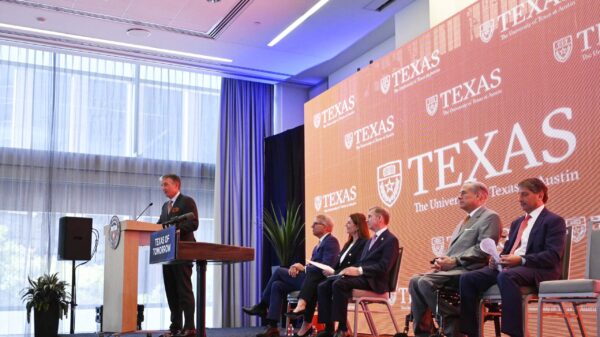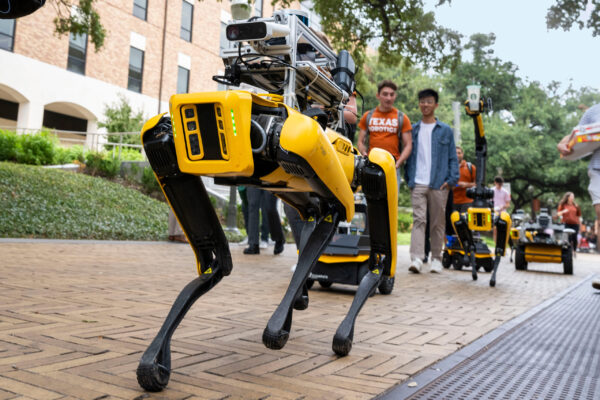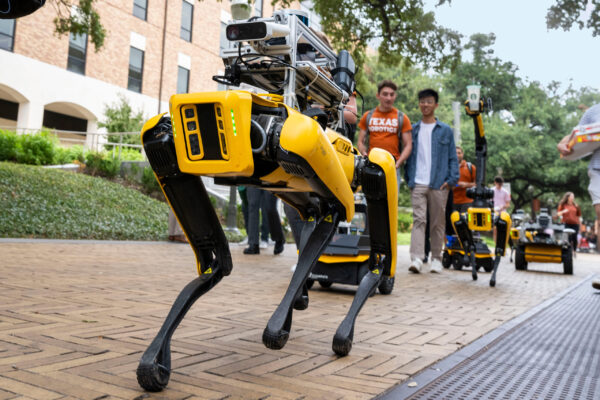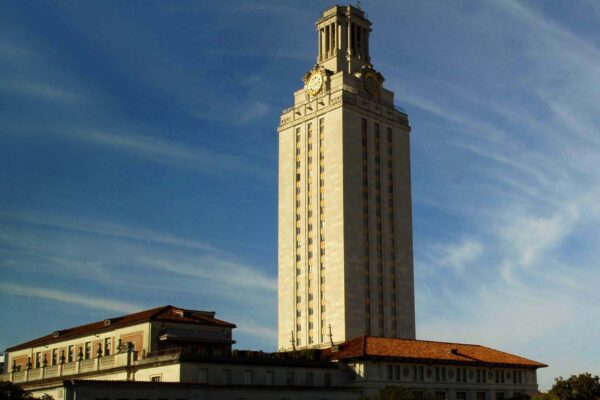In May 2022, The University of Texas at Austin rolled out Change Starts Here, an ambitious 10-year plan to make UT the highest-impact public research university in the world. The plan now has 43 initiative areas focusing on our people, our unique place and our pursuits. With his leadership team, President Jay Hartzell has chosen several of those priorities for the UT community to put special focus on and strategically invest in this coming year. Here are four of them:
Build an Integrated Academic Health Care System
Establish UT and Austin as a premier destination for health education, innovation and care
The University has launched a monumental health care initiative to accelerate and expand UT Austin’s burgeoning medical district into a world-class academic medical center for education, research and patient care. The University of Texas at Austin Medical Center will start with two new hospital towers — The University of Texas MD Anderson Cancer Center and a UT Austin hospital. MD Anderson, the nation’s No. 1 cancer hospital and a component of the UT System based in Houston, will expand its footprint to Austin by building and operating a new, comprehensive cancer center, while UT Austin will build and operate a new specialty hospital. Both are planned to occupy the current footprint of the Erwin Center, now being demolished.
“It’s important to think about what this means for patients,” says Dell Medical School Dean Claudia Lucchinetti. “What does the new UT Medical Center mean for patients in Austin and Central Texas? It means that you no longer need to travel to receive world-class and cutting-edge care.”
Increase Value and Affordability
Recognize and help mitigate the consequences of increasing costs in Austin
UT is working to help offset the cost of living for students, faculty and staff through housing, scholarships and financial partnerships. For example, the University and University Federal Credit Union have come together to bring new financial solutions to employees. The partnership will promote financial soundness and financial literacy and help employees not only make better-educated decisions but also teach them how to leverage a range of financial products customized to their needs.
“As an organization dedicated to the welfare of our faculty and staff, we actively seek innovative partnerships to increase affordability and provide unique value to our faculty and staff,” says Roger Cude, UT’s new vice president for people and talent. “Through custom financial products and tailored financial education opportunities, UFCU is well-positioned to provide value and support to our community.”
Examples of the products the credit union is expected to provide are specialty mortgage loans and pre-approved car loans, in addition to a suite of tailored financial-education and financial-literacy seminars. UFCU already has been providing financial education to UT employees for many years through the University’s HealthPoint Wellness program.
Nosse Ovienmhada is UT’s work life balance and wellness manager in Human Resources, and says, “Under this latest collaboration, UFCU will now be able to tailor education opportunities to the needs of our employees, providing even greater value and support.”

Technology and Society (Focus on AI)
Propel the leading edge of research at the intersection of technology and society
The need for skilled artificial intelligence (AI) professionals is greater than ever, with 97 million new AI-related jobs expected globally over just the next two years. UT’s new master’s degree in AI is preparing students to stand out in this fast-growing field through one of the first AI master’s programs available completely online. The coursework covers a range of highly sought-after skills to prepare Longhorns to lead AI innovations across industries from engineering and medicine to finance and project management.
The University has dozens of experts, thought leaders and top research programs in AI. “This is such an incredible time for UT Austin as we build upon our decades of growth and leadership in artificial intelligence,” says Melissa Taylor, who is senior assistant dean for strategic initiatives in the College of Natural Sciences and who is leading the University’s Year of AI efforts. “We have expertise across campus in every aspect of AI research and education. The lineup of events, programs and initiatives has been off to a strong start with many more exciting activities still to come through the year.”
“UT Austin has always been strong in the core areas of artificial intelligence,” says Bruce Porter, professor of computer science and chief science officer at SparkCognition. “This campus is where the talent and expertise come together — neural science, mathematics, statistics, data science and more — we have strength in every area.”
And UT will put all this leadership, expertise, research and teaching on display throughout the Year of AI.
Advance Interdisciplinary Study (Robotics)
Break down silos to advance learning across disciplines
There’s no better example of interdisciplinary study than what UT is doing in the field of robots. Texas Robotics includes 16 core faculty members, 40 affiliated faculty members, and 200 students, postdocs, visiting scholars and research engineers from four top-ranked departments at UT, including the Department of Aerospace Engineering and Engineering Mechanics, the Department of Computer Science, the Chandra Department of Electrical and Computer Engineering and the Walker Department of Mechanical Engineering.
Texas Robotics is producing research that solves pressing societal challenges in numerous application spaces, including social, surgical, rehabilitation, vehicles, drilling, manufacturing, space, nuclear and defense. On the education front, it’s developing tomorrow’s robotics leaders through a holistic graduate and undergraduate program, including offering a graduate portfolio program in robotics and an undergraduate minor in robotics. It’s increasing access and exposure to robotics through regularly hosting lab tours, camps, workshops, talks and robot demonstrations, especially for K-12 students and underserved populations. And it is collaborating with industry partners to expand UT’s impact on society, connect students to potential careers, develop innovative research, and bridge the gap between education and industry.
Sridevi Rao is the managing director of Texas Robotics, which brings disciplines together through its collaborative research projects. Housed in facilities at Anna Hiss Gym, students, faculty members and researchers from all over campus have dedicated space for collaboration. “Texas Robotics primarily combines students and faculty from the departments of Aerospace Engineering and Engineering Mechanics, Computer Science, Electrical and Computer Engineering, and Mechanical Engineering,” says Rao. “However, there are folks from education, English, psychology, the Good Systems grand challenge initiative, Machine Learning Lab, Oden Institute and more working with Texas Robotics as well. By integrating knowledge and skills from diverse disciplines, Texas Robotics can create innovative solutions that tackle complex challenges effectively and push the boundaries of what is possible when it comes to human-robot interaction, manipulation and grasping, and long-term autonomy.”
Rao says one example of this work is Farshid Alambeigi’s ARTS Lab, which is currently using generative AI for cancer detection and combines expertise from mechanical engineering, robotics, health care/medicine and artificial intelligence.
Visit the Change Starts Here website for more information and updates on these and other initiatives. strategicplan.utexas.edu



